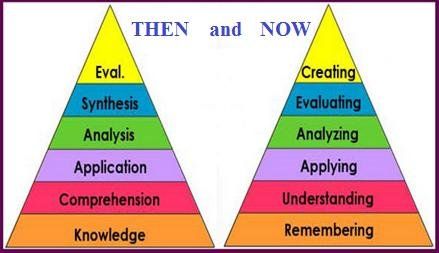The Original Bloom's Taxonomy
Bloom's Taxonomy was created by Dr. Benjamin Bloom in 1956 to promote higher forms of thinking in education. Bloom's Taxonomy is a hierarchical model that categorized learning objectives into varying levels of complexity, from basic to advance knowledge.
Bloom Taxonomy identified three learning domains, they are; cognitive, affective and psychomotor.
- Cognitive Domain; It focuses on the acquisition and application of knowledge and used in educational setting. There are six major categories of cognitive; knowledge, comprehension, application, analysis, synthesis and evaluation. This can be thought as the degree of difficulties. The first one must be mastered before the next one can take place.
- Affective Domain; The affective model came as an extension of Bloom's original work. This domain focuses on how we handle emotions, feelings, values, appreciation, enthusiasm, motivations and attitudes. There are five categories; receiving, responding, valuing, organisation and characterised by value set.
- Psychomotor Domain; This model focuses on the physical movements, coordination and anything related to motor skills. There are 6 categories; reflex movements, basic fundamental movement, perceptual, physical activities, skilled movements and non-discursive communication.

Bloom's Taxonomy Revision
In 2001, the original cognitive model was modified by educational psychologist David Karthwol (was worked with Bloom) and Lorin Anderson (was Bloom's previous student). The new taxonomy reflects more active form of thinking and also include another level of knowledge, which is metacognitive.

Level 1: Knowledge; This is the basic level. It is related to the memory on what the students have learnt in class. It is an ability to remember knowledge from memory. This is Lower Order Thinking Skills (LOTS)
Level 2: Understanding; This also part of LOTS, It is an ability to construct meaning. The students demonstrate understanding of the knowledge they remembered.
Level 3: Applying; is ability to use learned materials to new situations. This is LOTS.
Level 4: Analyzing; is ability to break information into parts to explore understanding and relationship. This part is Higher Order Thinking Skills (HOTS)
Level 5: Evaluating; is ability to justify decisions, make judgements based on criteria and standard. This is HOTS.
Level 6: Creating; is ability to put all elements together to form a new product. This is the Highest level in Bloom's Taxonomy.
Each levels above are conceptually different and also arranged in hierarchical structure.
S.W.O.T. Analysis:
As part of my reflection, I will try to analyse Bloom's Taxonomy method by using S.W.O.T. Analysis:
Strengths (S): Bloom's Taxonomy is really helpful for both students and teachers to learn. The student are encouraged to be more engaged in higher order thinking.
Weaknesses (W): Some argues that the order of this taxonomy is inaccurate. When we learn, we do not always start from remembering, instead some of us learn from applying or sometimes creating. Like for the example, when you learn to cook, you can not just learn by remembering the steps but for some of us, we will learn by actually do the cooking (applying) the skills. Sometimes, you learn when you actually do it.
Opportunities (O): The teachers are given opportunity to actually identify the intellectual level of the students in the teaching and learning process in the classroom.
Threats (T): The consistent application of Bloom's Taxonomy is challenging. The measurement about knowledge is considered of lower order thinking (LOT) and everything above knowledge is higher order thinking (HOT). At the end, teachers and students might just focus on how to achieve higher order thinking (HOT) and ignoring the basic level, which is the lower order thinking (LOT).
Thank you.
Baca konten-konten menarik Kompasiana langsung dari smartphone kamu. Follow channel WhatsApp Kompasiana sekarang di sini: https://whatsapp.com/channel/0029VaYjYaL4Spk7WflFYJ2H












